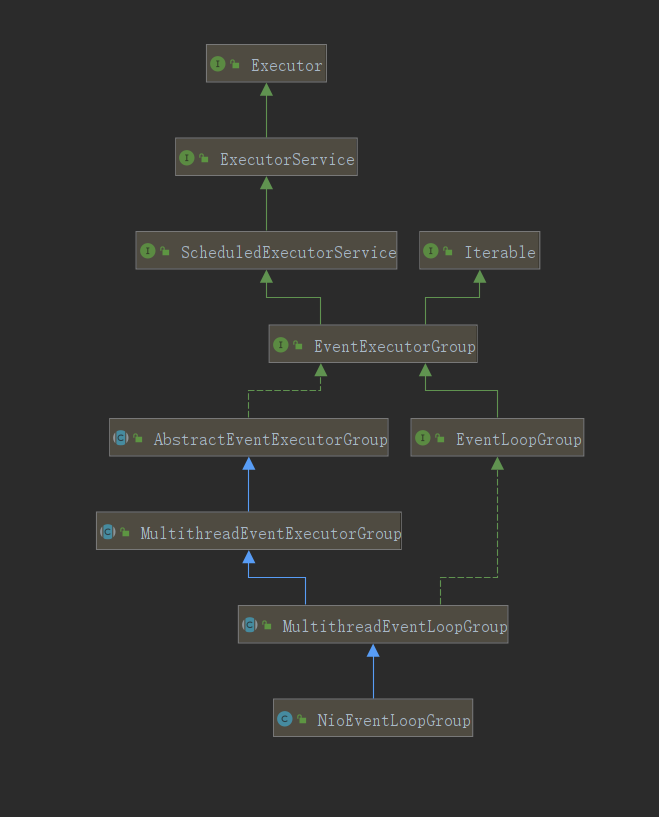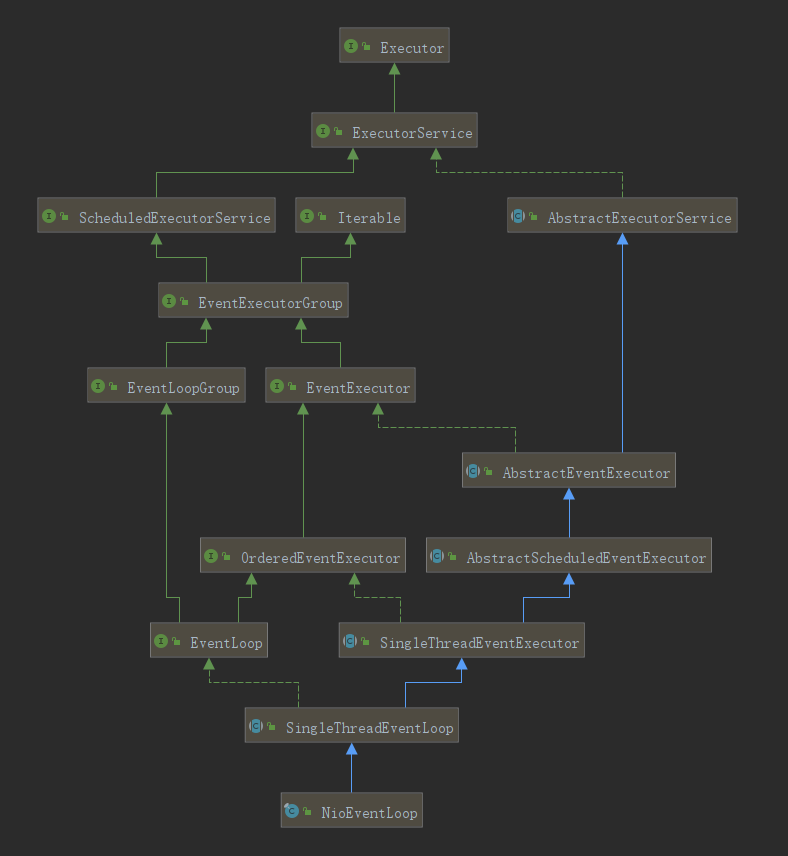netty核心组件之EventLoopGroup和EventLoop
这节我们着重介绍netty最为核心的组件EventLoopGroup和EventLoop
EventLoopGroup:顾名思义就是EventLoop的组,下面来看它们的继承结构


在netty中我们可以把EventLoop看做一个线程,当然线程不单是jdk中的的线程,它们都从Executor一路继承过来,NioEventLoop继承SinfleThreadEventLoop,从名字可以看出它是一个单线程的EventLoop,
我们先来看NioEventLoop是如何构造的
public NioEventLoopGroup() { this(0); } public NioEventLoopGroup(int nThreads) { this(nThreads, (Executor) null); } ~~~~~~~~~~~~~ public NioEventLoopGroup(int nThreads, Executor executor, EventExecutorChooserFactory chooserFactory, final SelectorProvider selectorProvider, final SelectStrategyFactory selectStrategyFactory, final RejectedExecutionHandler rejectedExecutionHandler) { super(nThreads, executor, chooserFactory, selectorProvider, selectStrategyFactory, rejectedExecutionHandler); }
NioEventLoop构造函数非常多,每个参数都可以定制,我就不全贴出来了,最后回到这个参数最全的构造函数,下面我们挨个解释每个参数的作用
- nThreads: 线程数,对应EventLoop的数量,为0时 默认数量为CPU核心数*2
- executor: 这个我们再熟悉不过,最终用来执行EventLoop的线程
- chooserFactor: 当我们提交一个任务到线程池,chooserFactor会根据策略选择一个线程来执行
- selectorProvider:用来实例化jdk中的selector,没一个EventLoop都有一个selector
- selectStrategyFactory:用来生成后续线程运行时对应的选择策略工厂
- rejectedExecutionHandler:跟jdk中线程池中的作用一样,用于处理线程池没有多余线程的情况,默认直接抛出异常
接着我们进入父类MultithreadEventLoopGroup的构造函数
protected MultithreadEventExecutorGroup(int nThreads, Executor executor, EventExecutorChooserFactory chooserFactory, Object... args) { if (nThreads <= 0) { throw new IllegalArgumentException(String.format("nThreads: %d (expected: > 0)", nThreads)); } if (executor == null) { executor = new ThreadPerTaskExecutor(newDefaultThreadFactory()); } // 创建nThreads大小的EventLoop数组 children = new EventExecutor[nThreads]; for (int i = 0; i < nThreads; i ++) { boolean success = false; try { // 创建具体的EventLoop,会调用子类NioEventLoopGruop中的方法 children[i] = newChild(executor, args); success = true; } catch (Exception e) { // TODO: Think about if this is a good exception type throw new IllegalStateException("failed to create a child event loop", e); } finally { if (!success) { // 如果其中有一个创建失败,把之前创建好的都关闭掉 for (int j = 0; j < i; j ++) { children[j].shutdownGracefully(); } for (int j = 0; j < i; j ++) { EventExecutor e = children[j]; try { while (!e.isTerminated()) { e.awaitTermination(Integer.MAX_VALUE, TimeUnit.SECONDS); } } catch (InterruptedException interrupted) { // Let the caller handle the interruption. Thread.currentThread().interrupt(); break; } } } } } // 把刚才创建好的EventLoop提供给EventExecutorChooser,用于后续选择 chooser = chooserFactory.newChooser(children); // 添加一个EventLoop监听器,用来监听EventLoop终止状态 final FutureListener<Object> terminationListener = new FutureListener<Object>() { @Override public void operationComplete(Future<Object> future) throws Exception { if (terminatedChildren.incrementAndGet() == children.length) { terminationFuture.setSuccess(null); } } }; for (EventExecutor e: children) { // 循环加入 e.terminationFuture().addListener(terminationListener); } // 将EventLoop数组转成一个只读的set Set<EventExecutor> childrenSet = new LinkedHashSet<EventExecutor>(children.length); Collections.addAll(childrenSet, children); readonlyChildren = Collections.unmodifiableSet(childrenSet); }
我们继续跟到父类NioEventLoopGroup中的newChild
protected EventLoop newChild(Executor executor, Object... args) throws Exception { return new NioEventLoop(this, executor, (SelectorProvider) args[0], ((SelectStrategyFactory) args[1]).newSelectStrategy(), (RejectedExecutionHandler) args[2]); }
可以看出先用来创建EventLoopGroup的参数其实都是用来创建EventLoop的,我们继续跟NioEventLoop的构造
NioEventLoop(NioEventLoopGroup parent, Executor executor, SelectorProvider selectorProvider, SelectStrategy strategy, RejectedExecutionHandler rejectedExecutionHandler) { super(parent, executor, false, DEFAULT_MAX_PENDING_TASKS, rejectedExecutionHandler); if (selectorProvider == null) { throw new NullPointerException("selectorProvider"); } if (strategy == null) { throw new NullPointerException("selectStrategy"); } provider = selectorProvider; // 创建selector,由此可见每一个EventLoop都会有一个selector final SelectorTuple selectorTuple = openSelector(); selector = selectorTuple.selector; unwrappedSelector = selectorTuple.unwrappedSelector; selectStrategy = strategy; } protected SingleThreadEventExecutor(EventExecutorGroup parent, Executor executor, boolean addTaskWakesUp, int maxPendingTasks, RejectedExecutionHandler rejectedHandler) { super(parent); this.addTaskWakesUp = addTaskWakesUp; this.maxPendingTasks = Math.max(16, maxPendingTasks); this.executor = ObjectUtil.checkNotNull(executor, "executor"); // 用来添加task的阻塞队列 链表结构 taskQueue = newTaskQueue(this.maxPendingTasks); rejectedExecutionHandler = ObjectUtil.checkNotNull(rejectedHandler, "rejectedHandler"); }
这里我们只是创建EventLoop,同时设置了执行的线程池、selector、taskQueue,并添加一个监听器用来监听它们的关闭状态,当所有线程都全部处于关闭状态terminationFuture会被置为true,到此还是没有实际创建可执行的thread。
后续我们在介绍channel的时候就知道EventLoop和channel如何建立关系,什么时候执行线程,我们姑且把EventLoop当做一个可执行runnable的netty线程

